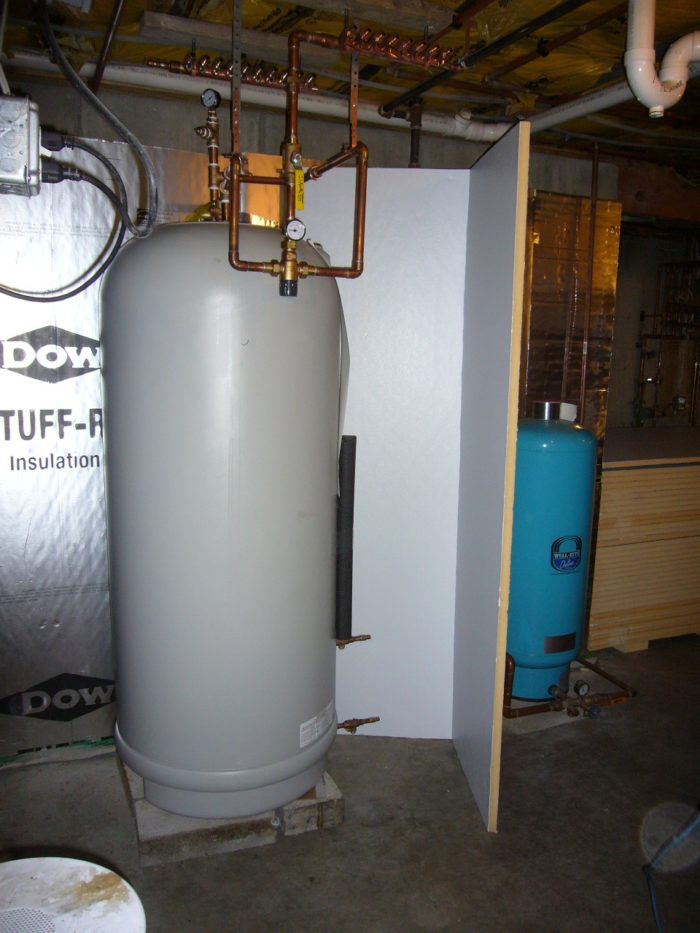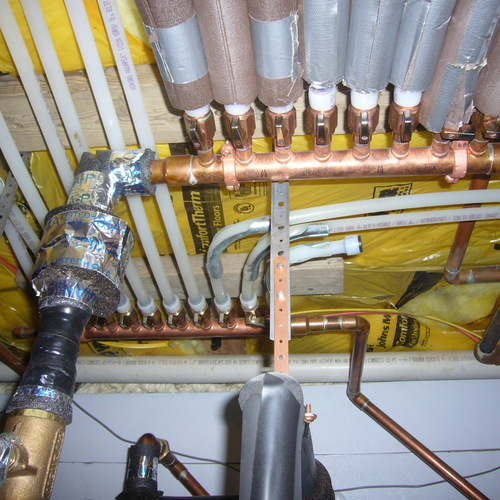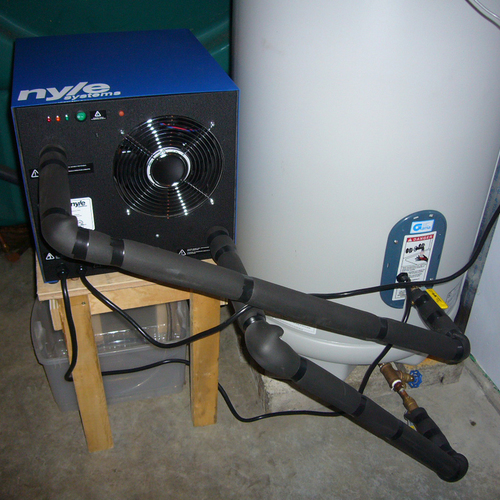
Image Credit: Marc Rosenbaum
Dick and Tim Mavro, with the help of a large friend of Tim’s named Justin, came and took our oil heating system away. I was glad to see the truck drive off with all that equipment on the trailer. Now I have to find a home for the Vermont Castings gas heater, and then we’ll be fossil-fuel-free, at least as far as site energy is concerned.
Once we said goodbye to the Buderus boiler, we needed a solution to making our domestic hot water (DHW). I installed a 10-gallon electric water heater I had as a temporary solution. Jill and I needed to time our showers with other uses of DHW or we’d get chilly. We went along for a few weeks like this.
No fossil fuels, thank you
Once we eliminated fossil fuels as the fuel source for making DHW, our choices narrowed to using electricity or solar. In some cases, such as our former home in New Hampshire, biomass can be an option. We used a heat exchanger in our old pre-EPA Vermont Castings wood stove and a thermosyphon solar water heater with a back-up electric resistance element in that system.
But that solution today either requires using a dirty old stove, or possibly finding and importing a European wood stove that includes a hot-water coil while retaining a clean burn. As I wrote in a previous blog (“The Right Target, Part 2”), I didn’t anticipate that we would be burning wood the whole heating season, but rather using wood where it makes the most sense — during the coldest portion of the year — and using the air-source heat pump in the swing seasons, when it is more efficient and keeping a stove going is challenging. The restricted time of use makes wood-fired DHW less compelling.
We want a big tank
I decided that whatever technology we would use to heat water would require a sizable, very well insulated tank, so I ordered an 85-gallon Marathon electric water heater. The Marathon has a polybutylene inner tank liner, which is durable enough for the manufacturer to offer a lifetime warranty. The insulation is continuous closed-cell foam, and the outer jacket is plastic, so no rust.
The Marathon heater doesn’t come with an internal heat exchanger, unlike tanks designed to be heated with an external heat source such as a boiler, solar thermal collectors, or stand-alone heat pump, so I knew that whatever I did I would have to implement a heat exchanger as part of the solution (if I chose to do something other than use the Marathon as an electric-resistance water heater.)
We don’t use much hot water
One aspect of the decision about what technology to choose to make DHW is how much hot water is needed.
I lived in two successive houses I had built, for thirty years, with passive solar hot water systems that were built into the design of the homes and used no pumps, power, controls, or antifreeze. These systems can’t be easily retrofitted into a conventional home. This means that a solar thermal system will typically have some of the above-mentioned cost-and-complexity adding components, which raises the cost.
Professionally installed solar thermal DHW systems in New England seem to end up costing $6,000 to over $12,000, depending on size and difficulty of installation. Some of that cost is relatively fixed, regardless of system size, and therefore the economics of solar DHW is dependent on the DHW usage (and of course, the cost of energy — natural gas is much less costly per energy delivered than the fuels available on Martha’s Vineyard, which are fuel oil, propane, and electricity).
Jill and I use an average of 13.3 gallons of DHW at 120°F per day. With an average annual incoming water temperature of 60°F (an estimate; the temperature may be somewhat lower over the year — I just have summer and early fall data), this is just about 2 kWh/day of DHW load. Add to that perhaps 1 1/2 kWh/day of heat loss off of the tank and piping near the tank (it’s insulated — we’ll get to this), for a total of 3 1/2 kWh/day.
This is close — we were using about 3 kWh/day with the much smaller and much worse insulated 10-gallon electric water heater we used for a few weeks. So 3 1/2 kWh/day is just under 1,300 kWh/year, at a cost on Martha’s Vineyard of just under $250.
Solar collector sizing
This 1,300 kWh/year is the annual output of roughly 26 square feet of solar collector, and if we did have this small collector it wouldn’t make all the DHW we need because it would make more than needed in the summer and less in the winter. But a single 26-square-foot collector is a very small system that still needs mounting racks, piping from the collector from the roof to the basement, pumps, controller, heat exchanger, pipe insulation, and installation labor — plumbing, wiring, solar installing — which don’t scale with system size.
If we were a larger family and, instead of using a somewhat European amount of 6.6 gallons/person/day, we used 15-20 gallons/person/day, we’d be figuring on an 80-square-foot solar thermal system that might cost less than twice as much as the 26-square-foot system, and would deliver more than three times the usable energy — very different economics.
I looked at some interesting and innovative solar thermal systems in this process, and I’ll write about them in the next post. I didn’t initially choose solar DHW, in any case, so there’s a bunch more to say.
Marc Rosenbaum is director of engineering at South Mountain Company on the island of Martha’s Vineyard in Massachusetts. He writes a blog called Thriving on Low Carbon.
Weekly Newsletter
Get building science and energy efficiency advice, plus special offers, in your inbox.















14 Comments
DHW
Marc,
Did you consider a hybrid electric water heater at all? If not, why not? If so, what did you find that made you not chose it?
Bob
Response to Bob Rueter
Bob,
I'm not sure whether Marc will have a chance to answer your question.
In the meantime, Bob, I'll just say that this is Part 1 of a multi-part series of articles. This article does not describe the final version of Marc's domestic hot water system. Marc will discuss heat-pump water heaters in the his article.
No fossil fuels?
What solar PV are you using to offset the Electric Resistance Tank if you aren't going with Solar Thermal?
Mixing electric and thermal
I'm hoping that the next installation of this series will discuss the options for using efficient electrical DHW heaters with solar thermal. There are seemingly easy to install connections between solar thermal panels and electric hot water heaters, but is this really true? Between laundry, dishwashing, and showers, our household uses much more than 12 gal/person, so electricity costs for DHW run pretty high. I'm especially interested in the cost benefit of a hybrid DHW system. Can't wait until Part 2!
Looking forward to parts 2 and 3
Marc,
I'm looking forward to parts 2 and 3 of your series.
So far your experience mirrors our own and what we tend to advise our clients: For very low consumers of hot water (<30 gpd), it is hard to beat gtpv and a marathon. for medium users of hot water, heat pump water heater attractive (as long as the isn't in your living space).
And for larger users (families of 4 or 60+ GPD) it is still hard to beat a solar hot water system as the most efficient use of roof space and most cost effective HW solution. Obviously the economics vary depending on the other fuel choices and on the local incentives, but we find this logic pretty much holds in the three states where we do business (Maine, New Hampshire and Massachusetts).
~Fortunat
http://www.revisionenergy.com
I hope parts 2 and 3...
...shed light on why a household using just 13.3 gallons of DHW per day would saddle itself with the expense, volume, embodied energy, and standby loss associated with an 85 gallon storage tank heater.
A GE HPWH would have cost same or less, and the local space cooling associated with it heating 13.3 GPD from 60 to 120 (6650 BTU / day less compressor power, net perhaps 4,000 BTU / Day) would be trivial in winter, and a bonus in summer, not to mention a couple pints of dehumidification from what appears to be a basement.
Heck, though I'm normally loath to recommend them, a tankless electric resistance heater might have made more sense in this low daily usage application - at least in that case standby losses wouldn't loom quite so large relative to daily usgae.
That daily consumption is less than what we normally figure for a household of one, and even though I value high efficiency water heating more than any other energy geek I know, I never recommend enything other than stright resistance for such low daily usage.
My standard recommendation would have been a 30 gallon storage electric resistance tank heater, perhaps standing on a couple inches of blue board for good measure.
Solar thermal is completely beyond the pale, again owing to tiny daily usage and extremely high first cost. I suspect that the pump power used by a solar thermal would equal or exceed the compressor power of an HPWH, and perhaps even be close to what a straight resistance heater would use.
I will await developments...
Fascinating...
I love this series.
I too wondered about the 85-gallon tank for only two people.
What is GTPV?
I agree for such low volume use that a simple 30 gal electric would be sufficient. And at those low volumes adding PV makes more sense than solar thermal.
HPDW is a mixed bag in Colorado. Adding cold air in the winter on the cold days is a bad deal. I'm designing very small homes without the benefit of a basement or a large laundry/mud room so there are limits to where it can be located. Small house and small demand means the best location in in the kitchen or bath (usually back to back), therefore small electric storage tank. I also question an 85 gallon tank with such low demand.
Always looking for options for a passive solar preheat sysytem. A 15-20 gallon tank sitting inside, but in the sun.
Lunatics.... I agree with
Lunatics.... I agree with Marc.
Response to Richard Patterman
Richard,
I share your frustration with the spread of acronyms on Internet posts.
I'm just guessing, but GTPV probably stands for "grid-tied photovoltaics."
multi-hybrid DHW
Geesh – 1200 kwh/yr could be achieved with a one-kilowatt PV array that probably would cost half as much as the solar thermal system. I’m off-grid and went through this same thing last year. I now have a Marathon with 48 volt heating elements as a dump load for excess PV, Navien on-demand, and GFX drain water heat recovery. Gas water heating consumption is down 50% in the winter, and is practically nothing in the summer. Full details here. http://nrgrevolution.blogspot.com/2011/09/whats-next.html
Hot Water
Thanks
I am particularly interested in the hybrid systems and connections. Does anyone have success utilizing a water coil on a woodstove to supplement hot water in the winter using a clean wood stove? We have lots of wood...
For a family of 3 who only use shower, dishwasher and rare other use for hot water, we were planning a GE Heat Pump sitting near the woodstove in the basement (to offset cooling in the winter), considering adding grid tied photovoltaic in the future. We were also considering adding slab radiant heated with a woodstove to supplement heat on a planned near passive home build in New Hampshire as well. Is it possible? Thoughts on this?
@Brett - Read my blog
@Brett - Read my blog Thriving on Low Carbon - 4.76 kW Sunpower
@Fortunat - Always nice to hear from you! You've summarized my opinions well.
@Curt - I'm an experimenter and measurer, plus I knew we wouldn't own this house forever and the next owner will use more. In fact, our house is for sale.
@85 gallon size - I wanted to be able to use whatever low recovery rate technology I chose. Studies are showing that HPWHs with more storage have a higher EF due to less time using resistance heating. Stay tuned for Part 2 (and Part 3 when I write it)
@Paul - Nice to hear from you, too! Both the Navien and the drainwater heat recovery are good tools. I wanted no fossil fuels, but that is my own choice.
@Phil - Check out http://www.hydro-to-heat-convertor.com/index.html
Phil, when you build
Phil, when you build superinsulated you don't need every trick in the book. Lots to read here as to less is more. Ie radiant floors, PH builds don't need that much heat so maybe only some areas.
Log in or create an account to post a comment.
Sign up Log in